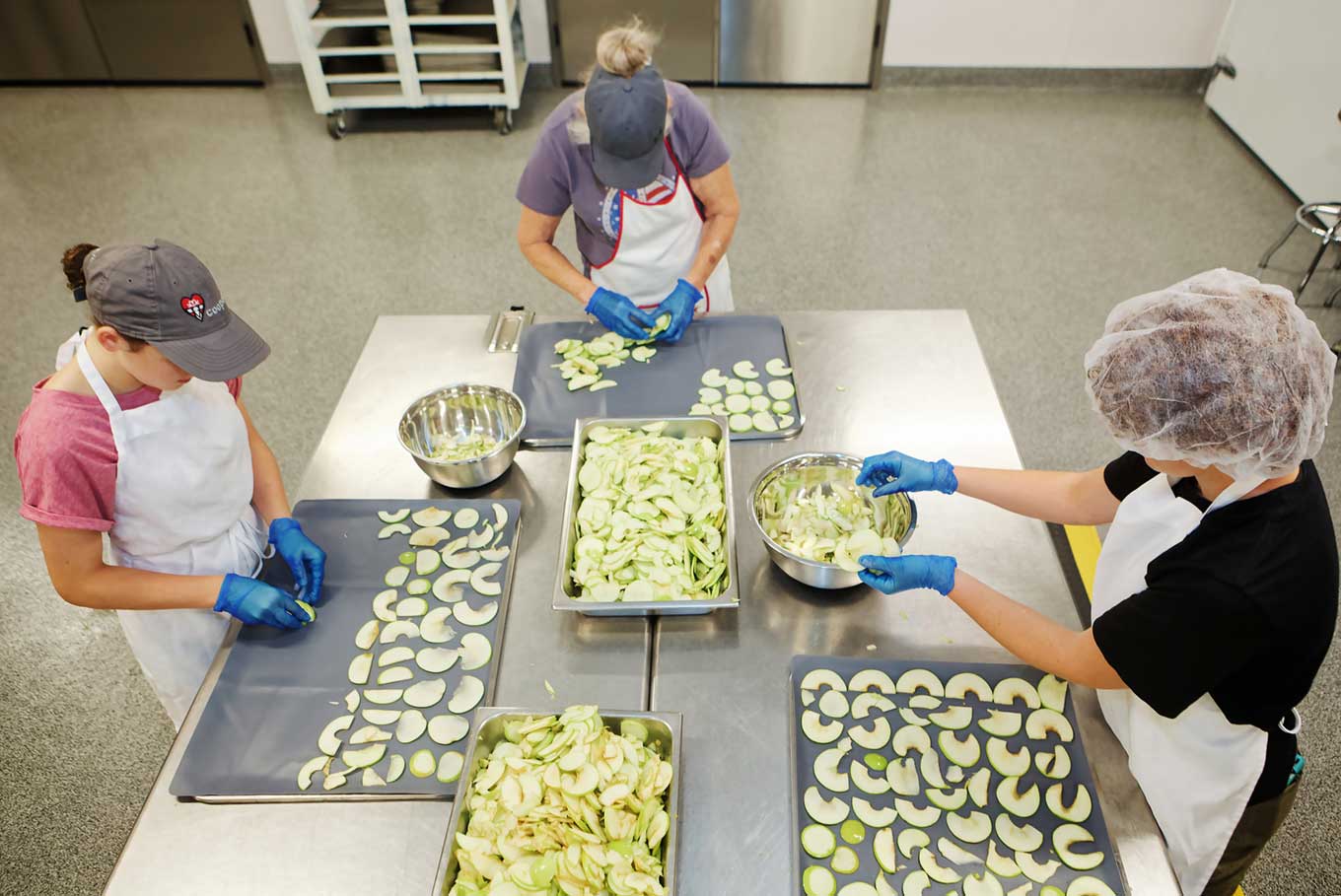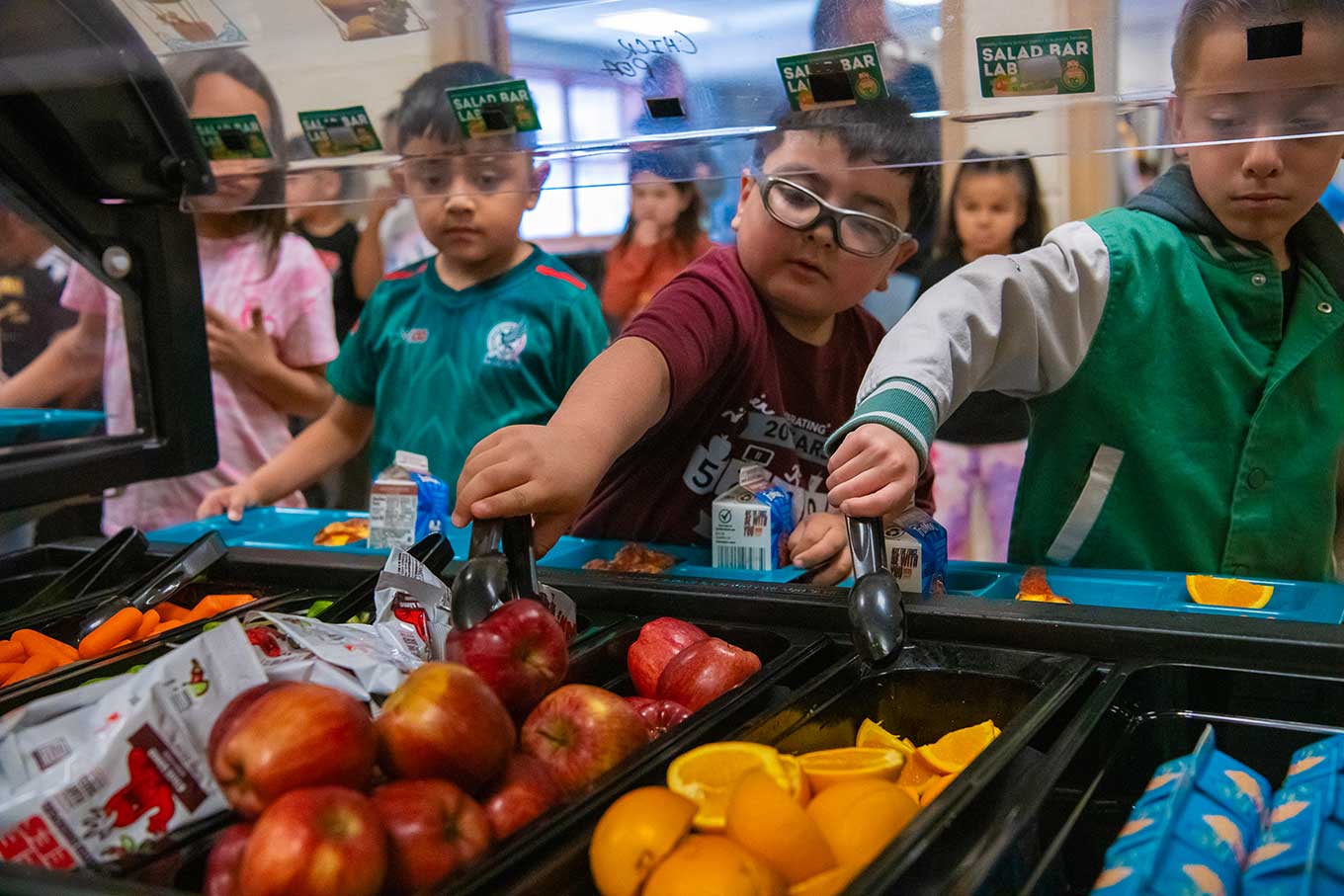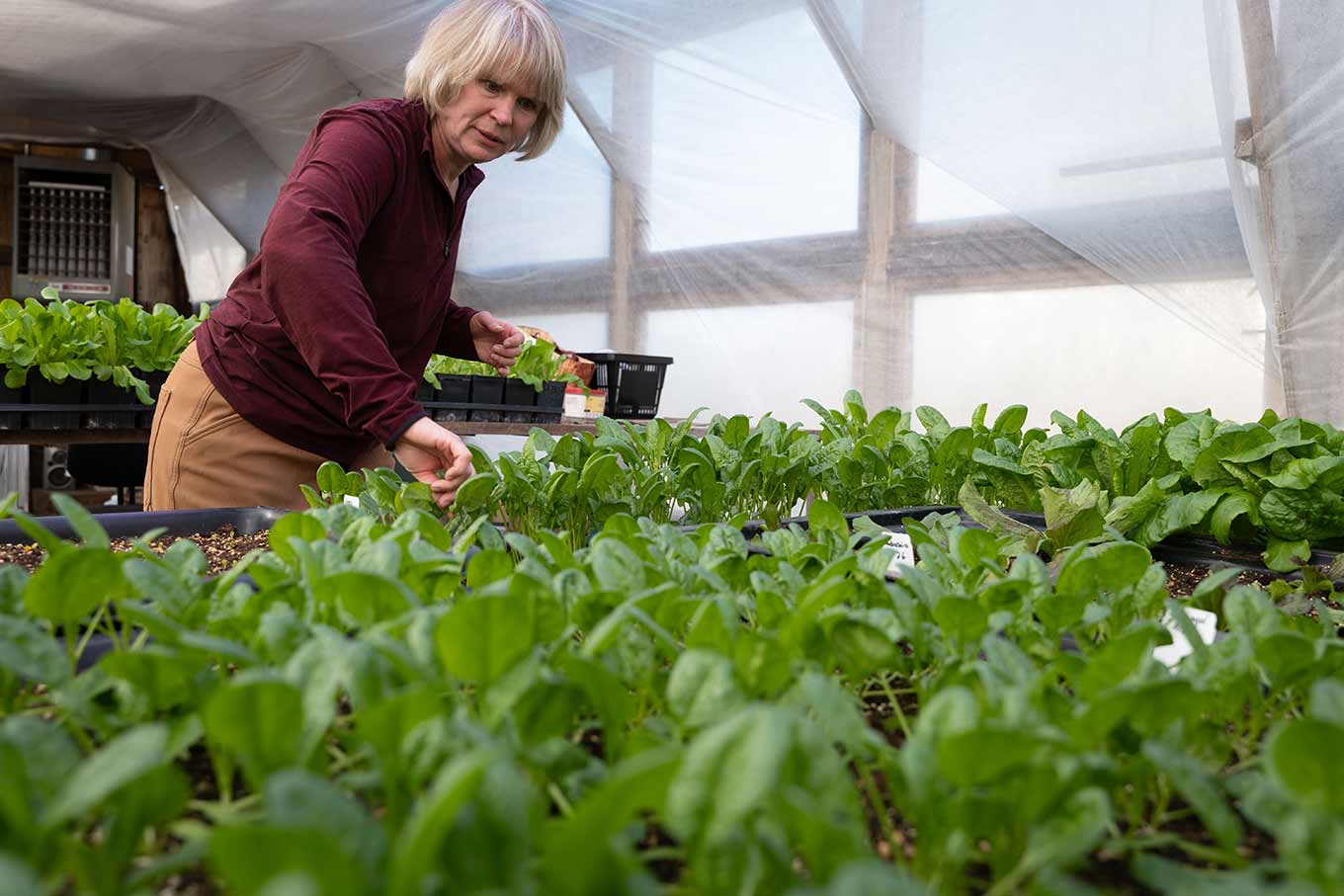With her sequined cap sparkling in the fluorescent lights and a grinning cartoon frog on her apron, Kathey Swisher is a blur of activity in the dehydration room at the Food Bank of the Rockies Western Slope distribution center.
It’s the first week of May, and Swisher is directing volunteers as they core and slice apples and place the pieces on wire trays that are then popped into closet-sized dehydrators overnight. The dried fruit gets bagged up and placed in backpacks and food boxes to be delivered to children as an in-demand substitute for candy.
“Isn’t the taste just va-va-va-voom?” Swisher, who leads the food bank’s dehydration operations, exclaims as a visitor munches on dried apple.
Grade school students at Riverside Education Centers agree. They recently sent a card to the food bank, thanking the staff for the snacks that fill their backpacks.
“Thank you for the dry apples and all of the other snacks… everything was delicious,” wrote Robin.
“Thank you for the delicious food!” wrote Maddee in six bright marker colors.
The Grand Junction-based food bank can take this extra step with its food donations—operating the only food bank dehydration program in the Feeding America nationwide network—because of its location in the middle of some of Colorado’s prime orchard country. When bumper crops and more fruit than the market demand are available, growers either donate or sell their produce to the food bank at a steep discount.
Fruit is only part of the food bank’s successful mission to ensure that nearly a third of its food in the 13-county Western Slope area is locally sourced fresh meat and produce. The food bank’s Etkin Family Distribution Center can also draw from various vegetable and livestock operations.
The high percentage of fresh food that goes into distribution boxes “puts us in the upper echelon of food banks nationally,” said Sue Ellen Rodwick, director of the food bank.
It also makes the food bank a significant buyer of local food and a partner in efforts to maintain a healthy local agricultural industry. The food bank is considered a major agricultural customer along with schools, hospitals and correctional facilities.
“It’s a definite benefit for our growers. We ship to places like Whole Foods and Sprouts, but this gives us a local avenue to sell more fruit,” said Debbie Dees, the general manager for the Rogers Mesa Fruit Co. packing operation in Delta County. “I appreciate what the food bank is doing. They are getting fruit to people that might otherwise not get it.”

Kathey Swisher, who leads dehydration operations for the Food Bank of the Rockies Western Slope, processes apples for dehydration on Friday, July 19, 2024, at the food bank’s distribution center in Grand Junction, Colo. Photo by Barton Glasser / Special to The Colorado Trust
Janie VanWikle, a local rancher, has sold about 40,000 pounds of discounted beef to the food bank in the past three years.
“I am spreading the word that you can sell to the food bank,” Van Winkle said.
VanWinkle is now leading a new initiative called AgriWest that could result in more local meat going to the food bank. AgriWest aims to help maintain agricultural sustainability and aid food security systems in western Colorado.
The food bank and local food producers have long had a symbiotic relationship. However, the partnerships got a boost during the COVID-19 pandemic when the federal government started funding the Local Food Purchase Assistance program.
The effort had a dual aim. With restaurants closed and people not shopping in stores, demand was down for a time. The partnership helped keep Western Slope agriculture businesses afloat at a time when farmers and ranchers were having to cull livestock herds and plow under crops. It was also designed to address food insecurity among those suddenly out of work during the pandemic.
Even as the pandemic ebbed, the demand for food support did not. Rodwick, who leads the food bank, said the demand for food in Grand Junction has increased 50% since 2019. This year, the food bank expects to give out around 12 million pounds of food. Its local meat and produce comes from 26 fruit and vegetable growers, three ranches and two food hubs, which serve as distribution points for numerous crops.
In 2019, before the pandemic hit, the food bank sourced 188,000 pounds of local produce and meat from growers and ranchers. Last year that jumped to 769,382 pounds.

Alberto Ruiz, a worker at Talbott Farms, picks peaches on Thursday, July 25, 2024, in Palisade, Colo. Talbott Farms, a six-generation fruit growing operation, often partners with the Food Bank of the Rockies, including helping establish its food dehydration program. Photo by Barton Glasser / Special to The Colorado Trust
Rodwick said the food bank still needs more healthy protein sources. That is how the center partnered with VanWinkle and her family’s cattle operation.
VanWinkle said the food bank called her during the COVID-19 shutdown and asked if the facility could buy some beef, which she found surprising.
“I always thought it was all donated food,” she said.
The food bank has been involved in helping VanWinkle get AgriWest up and running, an effort that VanWinkle hopes will become a model for other agricultural areas in the country.
“We see the food bank as a partner in figuring out a solution to help an industry that hasn’t bounced back from COVID like other industries,” Rodwick said.
The AgriWest initiative was funded with $262,500 from the federal Economic Recovery Corps granted to the Grand Junction Business Incubator Center.
VanWinkle said the tricky part of the initiative is navigating the complications of aggregating food for sale and getting the products to large local buyers like the food bank that could benefit from locally grown and raised fresh food.
An early example of the AgriWest effort is about to get a test run through the discounted sale of ground beef to Grand Valley District 51 schools. Four ranches, including VanWinkle’s, sell cattle to the district that will be processed locally and eventually end up on school lunch trays.
“It’s a cool thing to develop these relationships locally,” VanWinkle said.
As efforts like AgriWest offer road maps for making symbiotic local food sales and farm-to-food-bank relationships more of an ongoing partnership, the food bank is preparing for a season of plentiful fruit that will end up in its coolers and the dehydrating room. Fruit crops have mostly survived a spring freeze and several spotty hailstorms.
“If we see we are going to have too much, we give [the food bank] a bargain basement price,” said Charlie Talbott, one of the owners and the sales manager at Talbott Farms, a six-generation fruit growing operation in the Palisade area.
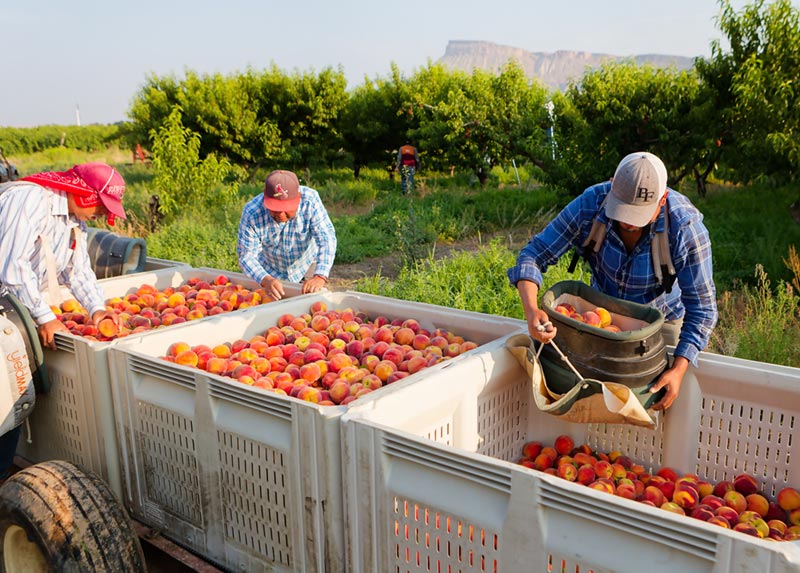
Migrant workers pick peaches on Thursday, July 25, 2024, at Talbott Farms in Palisade, Colo. Photo by Barton Glasser / Special to The Colorado Trust
Talbott, who has served on the food bank board of directors, has said that Talbott Farms has donated and sold fruit to the food bank in the past. It has also partnered to store food. When a freeze knocked out most of the peach crop in 2020, the Talbotts allowed the food bank to use their mostly empty cooler facility to store food.
Talbott Farms has also worked with the food bank to help get its dehydration program up and running. The Talbotts are experienced with dehydration because the company has long marketed dried fruit as one of its “value-added” products, Talbott said.
Last season’s fruit harvest showed what a single bountiful crop and an expanded processing facility could mean for the food bank. Growers harvested more apples than the market demanded. Some of those apples were considered seconds or thirds, meaning they were not the glossy, perfect orbs favored in grocery store bins. The smaller, misshapen or slightly bruised fruits were donated to the food bank.
The best apples were put into food boxes for distribution. The rest were sent to the fruit-scented dehydrator room, where volunteers have been drying apples and bananas since January.
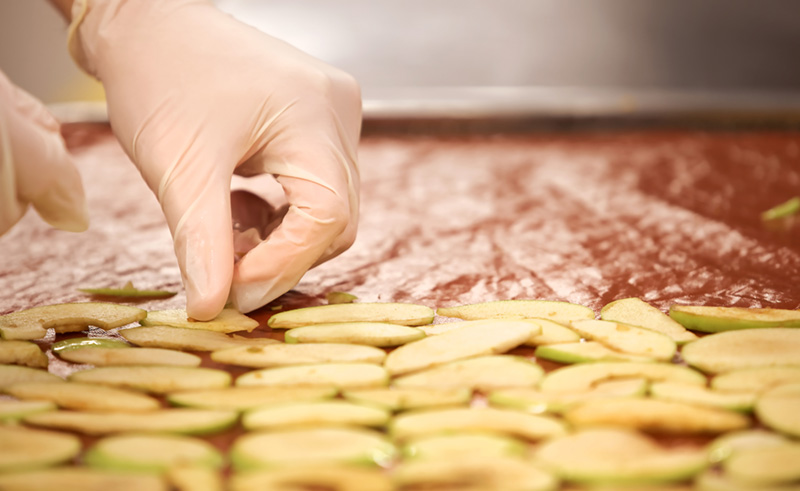
Rachel Hughes lays out apple slices for dehydration at the Food Bank of the Rockies Western Slope distribution center on Friday, July 19, 2024, in Grand Junction, Colo. Photo by Barton Glasser / Special to The Colorado Trust
The bananas, which turn into slightly chewy, lightly sweet disks when dried, aren’t grown on the Western Slope; instead, they are overstock products from area grocery stores. The volunteers who dried a mountain of bananas and a glut of apples are now preparing to move on to local peaches, plums, nectarines and pears.
So far this year, they have dried 5,419 pounds of fruit and produced 15,000 packages of dried fruit, putting them on track to overshadow the 8,000 pounds of fruit that went through the dehydrator room last year.
In addition to creating snacks for kids, another aspect of the dehydration program is cutting waste—an effort that has trimmed food waste to less than 2%. Swisher takes that waste-reducing mission seriously. When there is too much fruit to dry in slices, Swisher freezes chunks in a fruit salad-like mixture, purees them in blenders, and turns them into fruit leather—another popular item.
Even “waste” does not go to waste at the food bank. Any fruits that are too far gone for drying go into compost bins and are given to the several pig farms near the food bank. The crumbs from the dehydration room are also put to good use: They are placed in the bird feeders on the food bank’s patio.

Food Bank of the Rockies Western Slope employees and volunteers use the dehydrators, pictured on Friday, July 19, 2024, to dry produce for donations at the distribution center in Grand Junction, Colo. Photo by Barton Glasser / Special to The Colorado Trust
Swisher, who grew up nearby at a rural home with a large garden, said she could decrease waste even more. She plans to add vegetables to the drying room eventually. She has dried everything from dandelions to tomatoes in her home kitchen over the years and thinks she can make packaged soup mixes with dried vegetables.
Inside the dehydration room, boxes of cellophane-bagged dried fruits are piling up along one wall in large buckets marked “hunger relief.”
After the dried fruit is bagged, it is loaded onto pallets and divided among 800 backpacks that are distributed to kids through schools and distribution centers each week.
Rodwick said she knows the dried fruit is appreciated because when the dehydration program had to go on hiatus during the pandemic, food bank patrons were asking when it would be back. The kids missed it.
“Everyone should have local food,” Rodwick said. “Being in the midst of this region and having so much abundance, we can help with that.”
